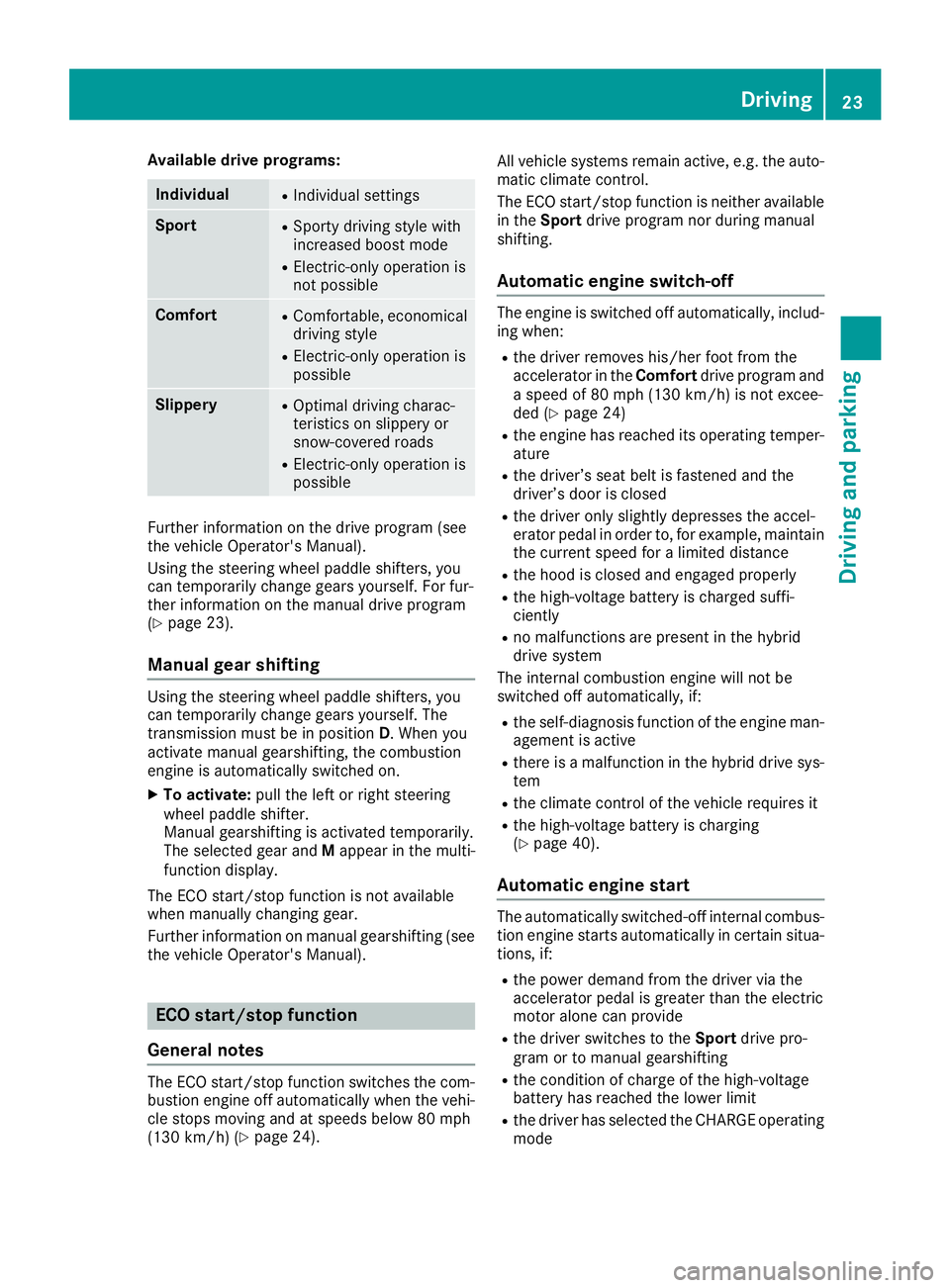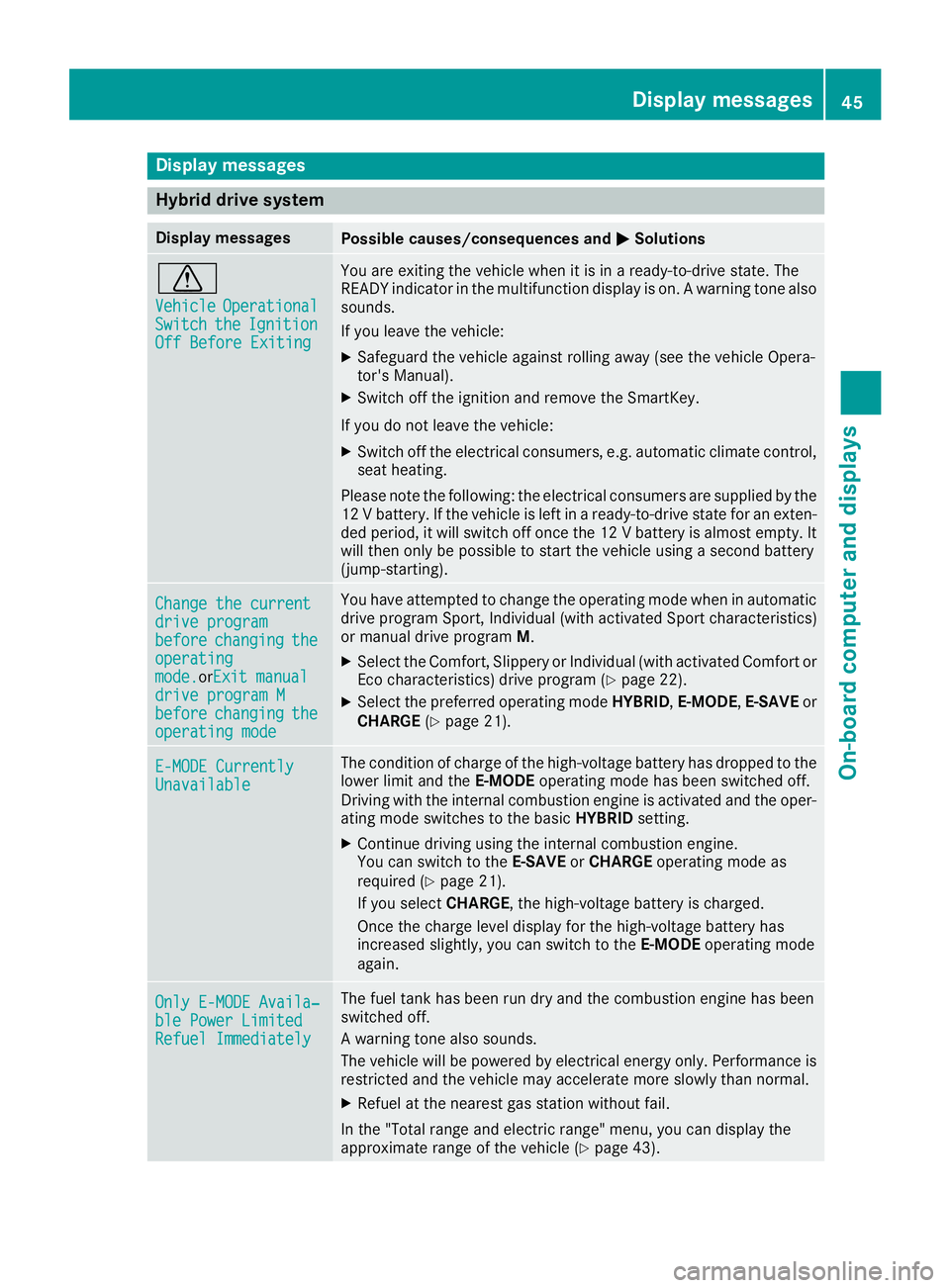2017 MERCEDES-BENZ GLE HYBRID sport mode
[x] Cancel search: sport modePage 25 of 58

Available drive programs:
Individual R
Indivi dual settings
Sp ort R
Spo rty driv ing style wit h
increased boost mode R
Electric-only operation is
not poss ible
Comfort R
Comfortable, economical
driv ing style R
Electric-only operation is
poss ible
Slippery R
Optimal driv ing charac-
teristics on slipp ery or
snow-covered roads R
Electric-only operation is
poss ible
Further information on the driv e program (see
the veh icle Operator's Manual).
Using the steering wheel paddle shifters, you
can temporar ily change gears yourself. For fur-
ther information on the manual driv e program
( Y
page 23).
Manual gear shifting Using the steering wheel paddle shifters, you
can temporar ily change gears yourself. The
transmission must be in position D . When you
activate manual gearshifting, the combustion
engine is automatically swit ched on.X
To activate: pull the left or right steering
wheel paddle shifter.
Manual gearshifting is activated temporar ily.
The selected gear and M appear in the mult i-
function display.
The ECO start /s top function is not availab le
when manually changing gear.
Further information on manual gearshifting (see
the veh icle Operator's Manual).
ECO start/stop function
General notes
The ECO start/stop function swit ches the com-
bustion engine off automatically when the veh i-
cle stops moving and at spee ds below 80 mph
(13 0 km/ h) ( Y
page 24). All vehicle systems remain active, e.g. the auto-
matic climate control.
The ECO start/stop function is neither available
in the Sport drive program nor during manual
shifting.
Automatic engine switch-off The engine is switched off automatically, includ-
ing when: R
the driver removes his/her foot from the
accelerator in the Comfort drive program and
a speed of 80 mph (130 km/h) is not excee-
ded ( Y
page 24) R
the engine has reached its operating temper-
ature R
the driver’s seat belt is fastened and the
driver’s door is closed R
the driver only slightly depresses the accel-
erator pedal in order to, for example, maintain
the current speed for a limited distance R
the hood is closed and engaged properly R
the high-voltage battery is charged suffi-
ciently R
no malfunctions are present in the hybrid
drive system
The internal combustion engine will not be
switched off automatically, if: R
the self-diagnosis function of the engine man-
agement is active R
there is a malfunction in the hybrid drive sys-
tem R
the climate control of the vehicle requires it R
the high-voltage battery is charging
( Y
page 40).
Automatic engine start The automatically switched-off internal combus-
tion engine starts automatically in certain situa-
tions, if: R
the power demand from the driver via the
accelerator pedal is greater than the electric
motor alone can provide R
the driver switches to the Sport drive pro-
gram or to manual gearshifting R
the condition of charge of the high-voltage
battery has reached the lower limit R
the driver has selected the CHARGE operating
mode Driving 23
Driving and parking
Page 32 of 58

R
Never touch damaged components or the
damaged orange cables of the high-voltage
electrical system. R
Do not remove the covers of the high-voltage
electrical system components that are
marked with a warning sticker.
General notes
Method of operation The vehicle is equipped with a high-voltage bat-
tery for driving. The high-voltage battery stores
the energy needed to operate the electric motor
and releases it again.
The electric motor uses energy that has been
stored in the high-voltage battery when pulling
away, accelerating and during the journey.
In overrun mode, kinetic energy is converted by
means of energy recuperation into electrical
energy and stored in the high-voltage battery.
Information on overrun mode ( Y
page 24).
The high-voltage battery can be charged as fol-
lows: R
through energy recuperation while the vehicle
is in motion R
through the combustion engine while driving
in CHARGE operating mode ( Y
page 21)R
with the relevant charging cable at an electri-
cal outlet while the vehicle is stationary R
at a wallbox while the vehicle is stationary R
at a charging station while the vehicle is sta-
tionary
The high-voltage battery can be charged in a
nominal voltage range from 100 V to 240 V.
You can view the condition of charge of the high-
voltage battery in the multifunction display.
Information about this can be found under
"Energy flow display" ( Y
page 40).
High and low outside temperatures Low outside temperatures
At very low outside temperatures the maximum
power output of the high-voltage battery may be
reduced. The high-voltage battery is then no
longer able to provide the normal electrical
power output.
High outside temperatures
To prevent damage to the high-voltage battery
due to very high outside temperatures, the max- imum power output of the high-voltage battery
is reduced by the vehicle.
Energy consumption and electrical
range The maximum electrical range is generally
reduced by: R
high and low outside temperatures R
operating the climate control system R
switching on consumers
The battery's physical characteristics are such
that leaving the vehicle parked for long periods
at low outdoor temperatures without charging it
can lead to: R
a reduction in battery performance R
longer charge times
Notes on battery care Avoid storing or transporting the vehicle at
excessively high or low temperatures over a long
period.
If you park the vehicle and leave it stationary for
long periods: R
check the condition of charge of the high-
voltage battery more often R
connect the vehicle to a power supply
This prevents self-discharge and damage to the
high-voltage battery.
Terms of use Please note the information on exceptions and
limitations in warranty documentation and in
the Maintenance Booklet.
Handling the charging cable and charg-
ing cable controls Always read the notes on the charging cable on
the inside of the charge socket flap.
Do not leave the charging cable controls
( Y
page 32) hanging loose from an electrical
outlet. Otherwise, this could result in a poor
contact with the electrical outlet and malfunc-
tions when charging the vehicle.30
Charging the high-voltage battery
Driving and parking
Page 47 of 58

Display messages
Hybrid drive syste mDisplay messages
Possible causes/consequences an d �P Solutions
�r Vehicl e Operational
Switch the Ignition
Off Before Exitin g You are exitin g th e vehicle when it is in a ready-to-driv e state. The
READY indicator in th e multifunction display is on . A warnin g tone also
sounds.
If you leav e th e vehicle:X
Safeguar d th e vehicle against rollin g away (se e th e vehicle Opera-
tor' s Manual). X
Switc h of f th e ignition and remov e th e SmartKey.
If you do no t leav e th e vehicle:X
Switc h of f th e electrical consumers , e.g. automatic climat e control,
seat heating.
Please note th e following: th e electrical consumers are supplied by th e
12 V battery. If th e vehicle is lef t in a ready-to-driv e stat e fo r an exten-
ded period, it will switch of f once th e 12 V battery is almost empty. It
will then only be possible to start th e vehicle usin g a secon d battery
(jump-starting).
Change the curren t
drive progra m
before changing the
operating
mode. or E xit manual
drive progra m M
before changing the
operating mod e You hav e attempted to chang e th e operatin g mode when in automatic
drive program Sport, Individual (wit h activated Spor t characteristics )
or manual drive program M .X
Selec t th e Comfort , Slippery or Individual (wit h activated Comfort or
Ec o characteristics ) drive program ( Y
page 22).X
Selec t th e preferred operatin g mode HYBRID , E-MODE , E-SAVE or
CHARGE ( Y
page 21).
E-MODE Currently
Unavailable The condition of charg e of th e high-voltage battery has dropped to th e
lowe r limit and th e E-MODE operatin g mode has bee n switched off.
Driving wit h th e internal combustion engin e is activated and th e oper-
atin g mode switches to th e basi c HYBRID setting .X
Continue drivin g usin g th e internal combustion engine.
You can switch to th e E-SAVE or CHARGE operatin g mode as
require d ( Y
page 21).
If you selec t CHARGE , th e high-voltage battery is charged.
Once th e charg e level display fo r th e high-voltage battery has
increase d slightly, you can switch to th e E-MODE operatin g mode
again .
Onl y E-MODE Availa ‐
ble Power Limite d
Refuel Immediately The fue l tank has bee n run dry and th e combustion engin e has bee n
switched off.
A warnin g tone also sounds.
The vehicle will be powered by electrical energ y only. Performanc e is
restricte d and th e vehicle may accelerat e more slowly than normal.X
Refuel at th e nearest gas station without fail .
In th e "Total range and electric range" menu, you can display th e
approximat e range of th e vehicle ( Y
page 43).Display messages 45
On-board computer and displays Z